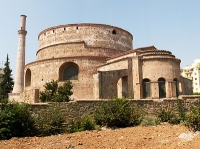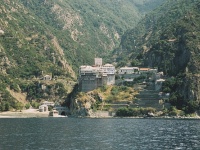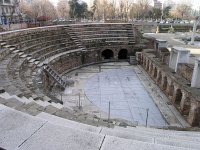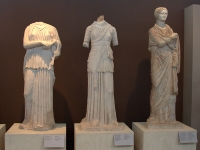
Most of Thessaloniki's beautiful churches are situated along the quaint, narrow-cobbled streets of the Upper City area. They date from various eras, including Byzantine.In particular, visitors should look out for the domed Church of Saint George. Its history goes back to the 4th century, when it was Roman Emperor Galerius' mausoleum. Agia Sofia is Thessaloniki's largest and most famous Byzantine church. The Agii Apostoli and the beautifully frescoed Agios Nikolaos Orfanos are also must-sees.Thessaloniki's churches are open to visitors, but often close during the afternoon. For this reason, visitors should try to tour them in the morning. Also, sightseers should follow local custom when entering. Essentially, this means to dress appropriately and to act respectfully in these sacred places. Visitors should ask permission before taking photographs. Some churches will not admit sightseers during services but tourists are always welcome to attend.
Website : www.enjoythessaloniki.com/visit/byzantine-churches/

Only men are welcome to make a pilgrimage to Mount Athos, the secretive 'Shangri-La' on a rugged promontory about 80 miles (129km) southeast of Thessaloniki. Here it is possible to step back in time and mingle with hundreds of monks, from more than 20 monasteries, in one of the most scenic spots in Europe. This unique, mountainous enclave on the coast is sprinkled with huge monasteries, most resembling castles, containing wonderful frescoes, mosaics and libraries. There are also smaller monasteries known as kelions attached to small churches, as well as caves on the mountain slopes where monks retreat as hermits. There are forests and pristine seashore, and beautiful gardens cared for by the monks. It is a truly astounding area to explore and there is nowhere quite like it in the world; unsurprisingly, it is a UNESCO World Heritage Site. Mount Athos is a self-governing area within Greece, and to visit it is necessary to obtain a permit from the Ministry of Foreign Affairs in Athens, or from the Ministry of Northern Greece in Thessaloniki. Women will unfortunately be unable to obtain such a permit, and the amount of visitors allowed daily is limited.
Website : www.mountathos.gr
Transport : Bus from Thessaloniki to Ierissos or Ouranoupoli and thence by Caique.

Towering above ancient Dion, about 48 miles (77km) south of Thessaloniki, is Greece's highest mountain, Mount Olympus, home to some of the famed Gods of Greek mythology. Olympus was the residence of the divine family, the twelve most important ruling gods and goddesses of ancient Greece, who therefore were called the Olympians. Olympus was not heaven but a dwelling place of the gods. The mountain is rich in tree and plant life, supporting more than 1,700 species, some very rare, and it is part of a National Park and a World's Biosphere Reserve. The main village in the area is Litohoro, which is connected to Athens and Thessaloniki by bus and train, and has been nicknamed the 'City of Gods' due to its location beneath the mountain. It is possible to climb the highest peak in about two days, and almost the whole hike is non-technical and can be done without experience or special equipment, along numerous mountain trails. However, the final ascent to the summit of Mytikas, the highest of Mount Olympus's 52 peaks, is a class 3 rock scramble and requires some skill and experience. About 10,000 people climb the mountain every year but most only reach the Skolio summit. Hikers generally set out from Litochoro.

Close to one of the city's main bus terminals in Dikasterion Square lies the archaeological site of the ancient Greek agora or marketplace, which was later expanded to become a Roman Forum on two levels. The Roman Forum was constructed in the late 2nd century AD and it constituted the administrative centre of the town till about the 5th century. The forum was the heart of the ancient city, and was discovered by workmen in the 1960s. The best-preserved component of the forum is the large theatre, which is still used for occasional summer concerts. On the southwest corner of the square is the magnificent church of Panagia Chalkeon. The Archaeological Museum built beneath the ruins houses some of the artefacts discovered in excavations on the site and a visit to the museum gives great context for exploring the site. It is small but captivating. Entry to the ruins is free but there are no written explanations, making the museum a necessary stop. The site is closed on Mondays. The area around the excavations is full of artists, shops and taverns and there are some wonderful little places to buy traditional wares and souvenirs.
Address : Thessaloniki 546 31
Website : www.inthessaloniki.com/en/roman-forum-roman-agora

The city of Thessaloniki's most famous landmark, the White Tower, was originally built as part of the city walls to fortify the coast during Ottoman rule. It now stands, no longer quite white but still very imposing, on the seaside promenade south of the Archaeological Museum, having been restored and offering panoramic views of the city and harbour from its rooftop café. Although now a proud landmark of the city, and the chosen symbol of its residents, the tower has a bloody history. It was used by the Ottomans as a prison, infamous for its brutality, and was the site for public executions; on the way up the winding staircase to the cafe visitors can peep into the dim rooms that were once used as cells. As a result of this notoriety as a brutal place it was known as the 'Tower of Blood' or the 'Red Tower' to local Greeks up until the end of the 19th century. When Thessaloniki was reclaimed by the Greeks the tower was whitewashed as a gesture of symbolic cleansing and it has since been re-imagined in the collective imagination as a positive symbol of freedom and pride. The tower contains a museum housing some Byzantine art and historical artefacts from Thessaloniki's history between 300 and 1,500 AD.
Address : Thessaloniki 546 21
Website : www.inthessaloniki.com/en/white-tower-museum

The Thessaloniki Archaeological Museum is regarded as one of the finest museums in Europe; it is near the famous White Tower and opposite the city's international fairgrounds. The museum houses a huge collection including the incredible treasures from the tomb of Alexander the Great's father, Phillip of Macedon, which was discovered at Vergina in 1977. Another treasured artefact is the 3rd century BC Derveni papyrus, the only intact ancient papyrus found in Greece, which was discovered in the tombs of Derveni. Other rooms in the museum contain exhibits depicting the history of the city from prehistoric days through to the Roman period, including spectacular mosaics and some exquisite, delicate Hellenistic glass. The museum will occupy visitors for a few hours if they are interested in history and archaeology and it is a well-organised and impressively laid out collection. Thessaloniki has a captivating history and it rewards investigation.
Address : Manoli Andronikou 6, Thessaloniki
Website : www.amth.gr

Vergina, known in ancient times as Aigai, is the most important of a cluster of three archaeological sites in the area connected with Philip, father of Alexander the Great. Vergina is where Philip built a massive palace and a theatre, and where he was assassinated in 336 BC. The palace has been excavated, as has the theatre, and the site also features hundreds of burial mounds, some dating from the Iron Age, across the plain. The tomb of Philip was found here undisturbed in 1977, full of treasures that are now on display in Thessaloniki's Archaeological Museum. The vast palace is full of amazing mosaics and paintings and is really exciting to explore, as are the tombs, which are surrounded by a museum and can be seen in all their ancient splendour. The site of ancient Aigai has been declared a UNESCO World Heritage Site and is a privilege to explore for those with an interest in ancient history and archaeology. Nearby is Pella, the remains of the former capital of Macedonia from the 5th century, where Alexander the Great was born; and Dion, an important religious sanctuary once frequented by Philip and Alexander.
Address : 38 miles (61km) west of Thessaloniki
Website : www.visitgreece.gr/en/culture/archaeological_sites/vergina

Travel Guide powered by Word Travels, copyright © 2023 Globe Media Ltd. By its very nature information in this travel guide is subject to change at short notice and travellers are urged to verify information on which they're relying with the relevant authorities. Neither Globe Media Ltd nor Travel Vogue can accept any responsibility for any loss or inconvenience to any person as a result of information contained above.